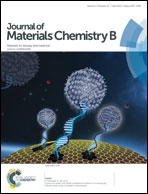Diol glycidyl ether-bridged low molecular weight PEI as potential gene delivery vehicles†
Abstract
A series of cationic polymers (P1–P5) were designed and synthesized using a ring-opening polymerization strategy based on low molecular weight polyethyleneimine (PEI) and using diglycidyl ethers as the bridging moiety. Although these polymers have reduced amino group density relative to 25 kDa PEI, their pH buffering capacity and deoxyribonucleic acid (DNA) binding ability were seldom affected. They were able to condense plasmid DNA (pDNA) well to form nanoparticles of suitable sizes (150–300 nm) and positive zeta potentials (+25–40 mV). Cell Counting Kit-8 (CCK-8) assays revealed that polyplexes formed from these polymers have lower cytotoxicity than those derived from PEI. Luciferase reporter gene delivery experiments indicated that these polymers have much better transfection efficiency than 25 kDa PEI, especially P2 and P5. Unlike PEI, serum has little negative effect on the transfection by these materials, and their transfection efficiencies were seldom reduced even with high concentrations of serum. Under optimized conditions, up to 400 times higher transfection efficiency than with PEI could be achieved. Several assays including gel electrophoresis, dynamic light scattering and transmission electron microscopy also confirmed the good serum tolerance of these polyplexes. The evenly distributed hydroxyl groups formed by the ring-opening polymerization are considered to contribute much to their high serum tolerance, and such polymerization might be a promising strategy for the design of efficient non-viral gene delivery vectors.


 Please wait while we load your content...
Please wait while we load your content...